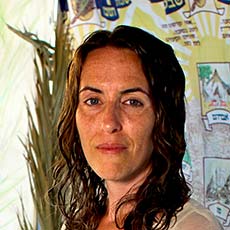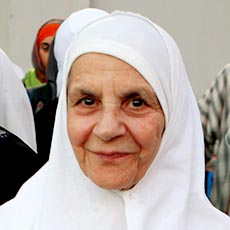Use the Google maps controls to explore the Hajj.
The Hajj
Premiered December 23 at 9/8C

The Hajj: At a Glance
One of the five pillars of Islam is that each believer is called, at least once in their lives, to make the Hajj, the annual pilgrimage that starts and ends in the holy city of Mecca located in today's Saudi Arabia. The journey recreates Muhammad's own path as the native son returned to his tribal home as the leader of a vibrant new religion. Unlike other sacred sites, Mecca is closed off to believers of other faiths: only Muslims are permitted on the Hajj.
| Religion: | Islam |
| Earliest pilgrimage on record: | 629 CE |
| Frequency: | Once a year |
| Duration: | 5 days |
| Annual participants: | Over 3 million |
| Following in the footsteps of: | Abraham and Muhammad |
Explore a Map of the Hajj
Begin the Journey
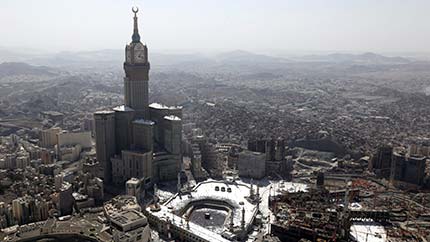
Mecca
Begin the Hajj in Islam's holiest city.
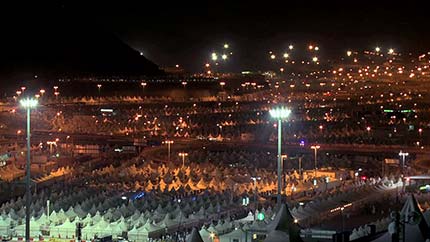
Mina
Head to Mina for a day of prayer and contemplation.

Arafat
Visit the place where Muhammad gave his last sermon.
Mecca
The Hajj begins in Mecca, Islam's holiest city and the birthplace of the prophet Muhammad. Pilgrims gather here once a year to recreate Muhammad's path as the native son returned to his tribal home the leader of a vibrant new religion.
Explore Mecca
"This is a life milestone that has been engrained in me as something that I need to do, something that I have to do."
—Husam Ansari, pilgrim to the Hajj
Mina
On the first day of the Hajj, fifteen thousand buses carry millions of pilgrims from Mecca to the Valley of Mina, five miles away, in a route laid out by Muhammad. Men dress in ihram—two cloths wrapped around the body—while women dress modestly, without jewelry or make-up. Worshipers spend a day and night here in prayer and contemplation, sleeping alongside other pilgrims in one of the thousands of tents erected for the pilgrimage.
Explore Mina
Bruce Feiler's Notes from the Field
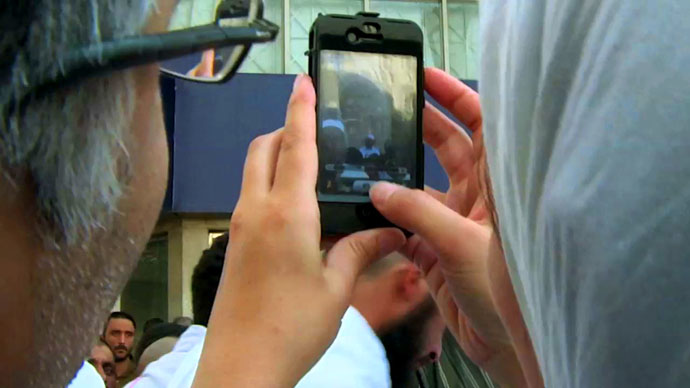
Citizen Journalists
Pilgrims can now easily capture and share their experiences on the Hajj with the rest of the world. How are technology and social media affecting the pilgrimage to Mecca?
"Who knows when something is going to touch you or not touch you, when you're going to get the closeness to Allah. Nothing can describe that feeling but also nothing can tell you when it's going to come."
—Jack Lindsay, pilgrim to the Hajj
Arafat
On the second morning of the Hajj, the pilgrims travel nine miles to the Plain of Arafat for the single most important event of the pilgrimage. Muslims believe that on this day, the divine descends to the lower heavens to listen to worshippers' requests for forgiveness. It was here, perched above the Plain of Arafat on the Mount of Mercy, where Muhammad gave his farewell sermon just months before he died.
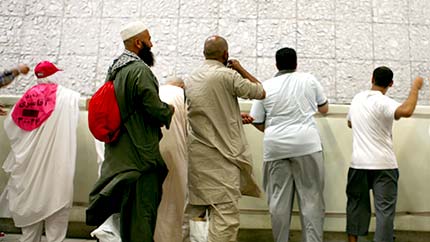
Valley of Muzdalifa & The Jamarat
Gather rocks for a ritualistic stoning of the devil.
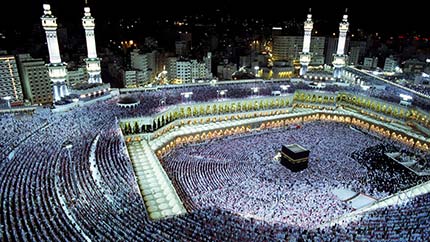
The Great Mosque
Circle the Ka'aba seven times as instructed by Muhammad.
Valley of Muzdalifa & The Jamarat
The second day of the Hajj ends at the Valley of Muzdalifa, where pilgrims gather stones for throwing in a ritual that symbolizes Abraham's defiance of the devil and is conducted upon returning to Mina the following day. Due to the large numbers of pilgrims, Hajj authorities are said to bring in tons of stones each year to restock the supply.
On the third morning of the Hajj, pilgrims move on to the penultimate stage of the pilgrimage, returning to Mina to stone the devil, which they do again and again in a vast, multi-level building with three massive stone pillars called the Jamarat that stand where Abraham is said to have himself confronted the devil.
"The throwing of the rocks, I almost didn't go because I really didn't think of it as anything significant, almost even silly, but I went, and the first one I was throwing rocks like I was throwing them at my own flaws, and the second one, I found myself asking for strength to overcome those, and the last one, I found myself feeling so alive."
—Amira Quraishi, pilgrim to the Hajj
Gallery: The Jamarat
The Great Mosque
The Hajj ends where it began, in Mecca. At the heart of this holy city is the Great Mosque. Covering almost 100 acres, its multiple levels and corridors are said to hold up to a million pilgrims at one time. At the center is the Ka'aba, which the Koran says was built by Abraham and Ishmael. Muslims consider it the "House of God" on Earth.
On the final night of the Hajj, pilgrims make the ritual known as Tawaf, circling the Ka'aba seven times while barefoot, as instructed by Muhammad. The ritual can take several hours to complete. At the southwest corner of the Ka'aba is a black stone encased in silver. Some Muslims believe that this is a stone from the heavens.
Explore the Great Mosque
"I feel like walking barefoot here because maybe the Prophet could have stepped in one of those places, you know. It's such an amazing feeling."
—Umar Salahuddin, pilgrim to the Hajj
"I truly was alone with God in a sea of five million."
—Umar Salahuddin, pilgrim to the Hajj
Gallery: The Hajj
More from PBS

The Story of India
In this landmark six-part series, Michael Wood embarks on a dazzling and exciting journey through today's India.

Walking the Bible
Join Bruce Feiler on an epic, ten thousand mile odyssey to explore the greatest stories ever told, in the settings where they occurred.

The Buddha
Narrated by Richard Gere, this documentary tells the story of the Buddha's life, a journey especially relevant to our own bewildering times of violent change and spiritual confusion.




